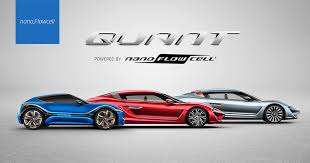
At the 2016 Geneva International Motor Show, nanoFlowcell AG is showed that safe and environmentally compatible electromobility is already achievable today. Its further development of flow cell technology, which generates energy from non-flammable, non-explosive electrolytes that are harmless to health and the environment, is new in itself – however, that flow cells can power a car represents a revolution for electromobility.
The nanoFlowcell® drives in the QUANTiNO and QUANT FE vehicles demonstrate that there is absolutely no reason for electric vehicles to be understated. With acceleration from zero to 100 km/h in 2.8 seconds and a top speed of 280 km/h, the nanoFlowcell® drive in the QUANT FE could hold its own even on the race track. The QUANTiNO, for its part, demonstrates the everyday usability of the nanoFlowcell® system. Despite its considerable performance – acceleration from zero to 100 km/h in less than five seconds and a top speed of 200 km/h – the mid-size sports car is designed for comfort and convenience. It has a highly contemporary interior design that exudes the inimitable electric feel. With space for four and a range upwards of 1,000 kilometres on just one tank, the QUANTiNO drives very much in the midst of life, satisfying society’s demands for individual mobility. And where other electric vehicles currently grind to a halt – be it in performance, range or space – the QUANT FE and QUANTiNO show that there is plenty more range and comfort to be had at zero cost to the environment.
The QUANTiNO was recently granted a road licence for Europe and, in its first endurance test, has been able to state its claim as the most advanced electric car. Driven by nanoFlowcell® inventor and Chief Technology Officer of nanoFlowcell AG, Nunzio La Vecchia, the QUANTiNO drove with nanoFlowcell® for 14 hours non-stop. Its average fuel consumption was around 12 to 14 kWh per 100 kilometres. When La Vecchia was forced to stop driving due to fatigue after 14 hours and three minutes, the two 159-litre electrolyte tanks in the QUANTiNO were still 78% full. This marks previously unheard-of endurance for a purely electric car and shows the potential of this innovative technology.
“With nanoFlowcell® we are demonstrating that electromobility no longer means having to make compromises. Our vehicles are sporty, dynamic, environmentally friendly and fuel efficient with zero harmful emissions,” said Nunzio La Vecchia. “We are showing in Geneva that the nanoFlowcell® technology we have developed is more than just an alternative for our mobility and to all other drive concepts. As we see it, nanoFlowcell® is the future of electromobility.”
La Vecchia continues: “What we are showing in Geneva is a feasible and concrete route to achieving sustainable, clean and safe mobility in the future. And we are open to taking that route with strong partners from the automotive industry.”
Find more information on the QUANTiNO and its revolutionary nanoFlowcell® drive at www.nanoflowcell.com.
About nanoFlowcell AG
Established towards the end of 2013, nanoFlowcell AG is an innovative research and development company headquartered in Lichtenstein. The focus of the research work performed by nanoFlowcell AG is on flow cell powertrain systems. Aside from further developing its QUANT range of vehicles, the company is also investigating possible applications of its nanoFlowcell® technology in other sectors and industries. To this end, two companies were founded in 2014, nanoProduction GmbH and nanoResearch SA, both wholly owned subsidiaries of nanoFlowcell AG.
For all the latest information on the development progress of the nanoFlowcell® system and the QUANT product family, please visit our website at www.nanoflowcell.com.











More Stories
EV Charging – ZOOZ Power’s Udi Tzuri on Flywheel Technology, Grid Solutions and Global Expansion
ENNOVI Introduces a New Flexible Circuit Production Process for Low Voltage Connectivity in EV Battery Cell Contacting Systems
ENNOVI Revolutionizes Battery Technology with the Introduction of ENNOVI-CellConnect-Prism